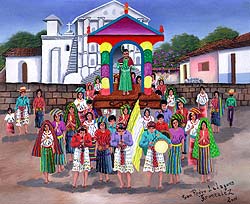
Procesión del Maximon
ca. 1977
25" x 28"
Pedro Rafael Gonzalez Chavajay
This painting, the earliest painting by Pedro Rafael Gonzalez Chavajay in the collection, clearly shows that when Pedro Rafael started painting he began with the style and colors used by his grandfather, Rafael Gonzalez y Gonzalez the first Tz'utuhil Mayan painter, and that of his uncle Jose Antonio Gonzalez Escobar with whom he worked from 1975 to 1976. Whereas the styles of Rafael Gonzalez and his son Jose Antonio Gonzalez would not change significantly throughout their lifetimes, the style and colors of grandson Pedro Rafael Gonzalez would change significantly.


Above left: Rafael Gonzalez y Gonzalez "San Pablo la
Laguna" probably painted in the 1970's and
Above right: Jose Antonio Gonzalez Escobar "Procesión, San Pedro la
Laguna" 2001.
When I first saw the painting, I was sure by the colors and style that it was done by Rafael Gonzalez, but it was only when I examined the signature and recognized Pedro Rafael's script that I realized my mistake. Kryssi Staikidis for her doctoral thesis spent time with Pedro Rafael learning painting from him and studying how he teaches his students. He teaches them to paint exactly like he paints. This painting shows that that is how he learned or was taught. He started out painting like his two relatives, the only two painters he knew at the time, and began by copying their colors and style exactly. Although the colors and style are inherited, on close inspection Pedro Rafael (with the exception of the background trees) paints everything more carefully than either of the family members he learned from. That precision holds true today. Pedro Rafael creates the most carefully painted works of any of the Tz'utuhil artists.
Of the subject of this painting, the procession of Maximon David Hamilton explains:
"On Good Friday in the Tz'utujil Maya town of Santiago Atitlán, two longstanding religious traditions of the village ritualistically confront one another in public. On this day, the annual penitents procession commemorates the crucifixion of Christ. Approximately 50 young Atiteco men dressed in their finest traditional dress emerge from the town's 16th century cathedral carrying an immensely heavy wooden bier on which rests the Holy Sepulcher containing the symbolic body of Christ. For the next 15 hours, until dawn of the following day, they inch slowly forward through village streets that have been decorated, using vividly colored sawdust and flower petals, with scenes of the life of Christ and other Catholic imagery. These "paintings" are a collective neighborhood project often not completed until moments before the procession arrives."When the bier has descended the perilously steep cathedral steps and traversed part way across the church courtyard, the renowned local Mayan idol, Maximon, emerges from his nearby chapel on the shoulders of his tenenel to join the procession. Maximon has been described as a mixture of Saint Peter, Judas Iscariat, and the hated conquistador, Pedro de Alvarado. He is also called "Lord of diviners and daykeepers. . . lord of sexual matters (who) watched over wives when husbands were away, but sometimes slept with them himself. . . the ancient Maya deity, Mam . . the year-bearer. . .the meeting of opposites, the soul of ambiguity."(1) In general, he is a principal symbol of traditional Mayan religious beliefs.
"In the center of the church courtyard, the two traditions meet and "spectators size them up to decide which of the two is more magnetic—the flamboyant and unregenerate Maximon, with his long history of debauchery, or the martyred Christ, with his dolorous face and colorful funeral cortege."(2)
(1) Time Among the Maya, Ronald Wright, p. 179.
(2) Unfinished Conquest, Victor Perera, p. 175.
The worship of Maximon has been the source of much conflict within the community especially when the local priests try and forbid the annual procession. In this painting Pedro Rafael shows Maximon being carried in a procession which descends the stairs from the plaza in front of the church in Santiago Atitlan.